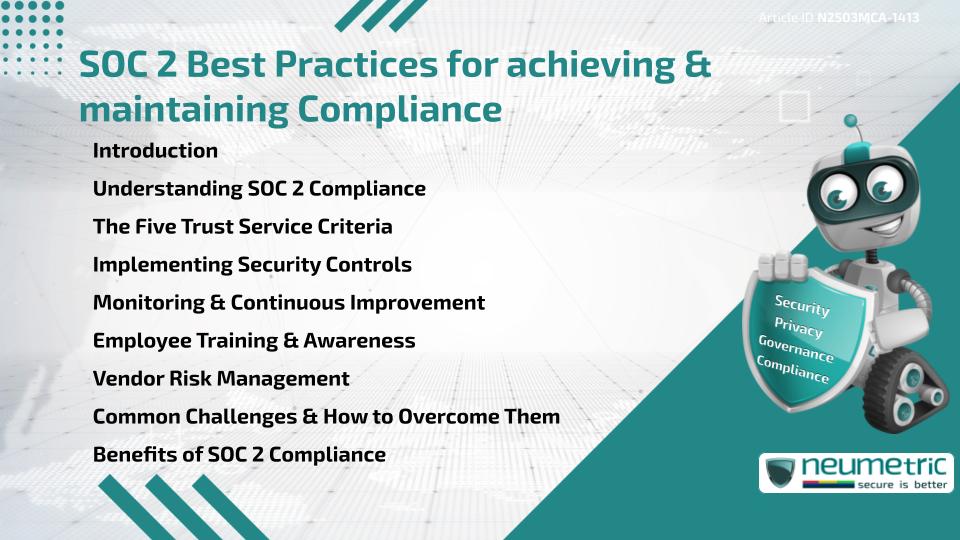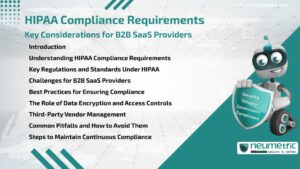Table of Contents
ToggleIntroduction
With increasing concerns about Data Security, organisations must implement effective safeguards to protect Sensitive Information. SOC 2 best practices provide a structured Framework for companies to ensure Data Security, Availability & Confidentiality. This article explores key principles & actionable strategies for achieving & maintaining SOC 2 Compliance.
Understanding SOC 2 Compliance
SOC 2, developed by the American Institute of Certified Public Accountants [AICPA], evaluates how organisations manage Customer Data. Unlike other Compliance Frameworks, SOC 2 is flexible & tailored to each company’s operational needs. Compliance is based on the Trust Service Criteria, which assess Security, Availability, Processing Integrity, Confidentiality & Privacy.
The Five Trust Service Criteria
To effectively follow SOC 2 best practices, organisations must align with the five (5) core principles:
- Security: Protecting Systems & Data against unauthorised access.
- Availability: Ensuring Systems remain operational & accessible.
- Processing Integrity: Maintaining the accuracy & reliability of data processing.
- Confidentiality: Restricting Data Access to Authorised Users.
- Privacy: Managing Personal Data responsibly & transparently.
Implementing Security Controls
A key step in SOC 2 best practices is implementing robust Security Controls. These include:
- Access Controls: Limiting System Access to Authorised Users.
- Encryption: Protecting Data in transit & at rest.
- Multi-Factor Authentication [MFA]: Adding an extra layer of Security.
- Incident Response Plans: Preparing for potential Security Breaches.
Monitoring & Continuous Improvement
SOC 2 Compliance is not a one-time effort. Organisations must continuously monitor Security Controls & update them as threats evolve. Regular internal Audits, automated monitoring tools & penetration testing help detect vulnerabilities & ensure compliance remains effective.
Employee Training & Awareness
Human error is a significant Security Risk. Educating Employees on SOC 2 best practices reduces the likelihood of Data Breaches. Training programs should cover:
- Recognizing phishing attempts.
- Safeguarding Login Credentials.
- Following secure data handling procedures.
Vendor Risk Management
Third Party Vendors can introduce security vulnerabilities. To minimise risks:
- Conduct thorough Vendor Security Assessments.
- Require SOC 2 Reports from Vendors handling Sensitive Data.
- Establish contractual obligations for Data Protection.
Common Challenges & How to Overcome Them
Organisations may face difficulties in implementing SOC 2 best practices, such as:
- Resource Constraints: Compliance requires time & investment. Solution: Prioritise security measures based on Risk Assessments.
- Complex Documentation: Maintaining detailed records can be challenging. Solution: Use Automated Tools to streamline Compliance Documentation.
- Adapting to Changing Threats: Cybersecurity Threats evolve rapidly. Solution: Stay updated with Industry Standards & conduct regular Security Reviews.
Benefits of SOC 2 Compliance
Following SOC 2 best practices provides numerous advantages:
- Enhanced Customer Trust: Demonstrates a commitment to Security.
- Competitive Advantage: Builds credibility with Clients & Partners.
- Regulatory Compliance: Aligns with industry requirements.
- Operational Efficiency: Improves Security Processes & Risk Management.
Conclusion
Adopting SOC 2 best practices strengthens Security, boosts Customer confidence & ensures Compliance with industry Standards. Organisations should continuously improve Security Measures, monitor Risks & educate Employees to maintain a robust Compliance Framework.
Takeaways
- SOC 2 best practices focus on Security, Availability & Confidentiality.
- Organizations must implement strong Security Controls & Regular Monitoring.
- Employee Training & Vendor Risk Management are essential for compliance.
- Continuous improvement is necessary to adapt to evolving Cybersecurity Threats.
FAQ
What is SOC 2 Compliance?
SOC 2 Compliance is a Framework developed by the AICPA to help organisations secure Customer Data based on the Trust Service Criteria.
Why are SOC 2 best practices important?
They ensure Data Protection, build Customer Trust & help organisations comply with Industry Standards, reducing Security Risks.
How can companies implement SOC 2 best practices?
By enforcing Security Controls, conducting regular Audits, training Employees & managing Vendor Risks effectively.
What are the biggest challenges in SOC 2 Compliance?
Challenges include resource constraints, complex documentation & adapting to evolving Security Threats.
How often should organisations review SOC 2 Compliance?
Regular Audits & Continuous Monitoring should be conducted to ensure ongoing Compliance & address Emerging Risks.
Need help?
Neumetric provides organisations the necessary help to achieve its Cybersecurity, Compliance, Governance, Privacy, Certifications & Pentesting goals.
Organisations & businesses, specifically those which provide SaaS & AI solutions, usually need a cybersecurity partner for meeting & maintaining the ongoing security & privacy needs & requirements of their Clients & Customers.
SOC 2, ISO 27001, NIST, HIPAA, HECVAT, EU GDPR are some of the Frameworks that are served by Fusion – a centralised, automated, AI-enabled SaaS solution provided by Neumetric.
Reach out to us!





